
Advanced-Prompt-Generator
Automating prompt engineering using AI Agents.
Stars: 85
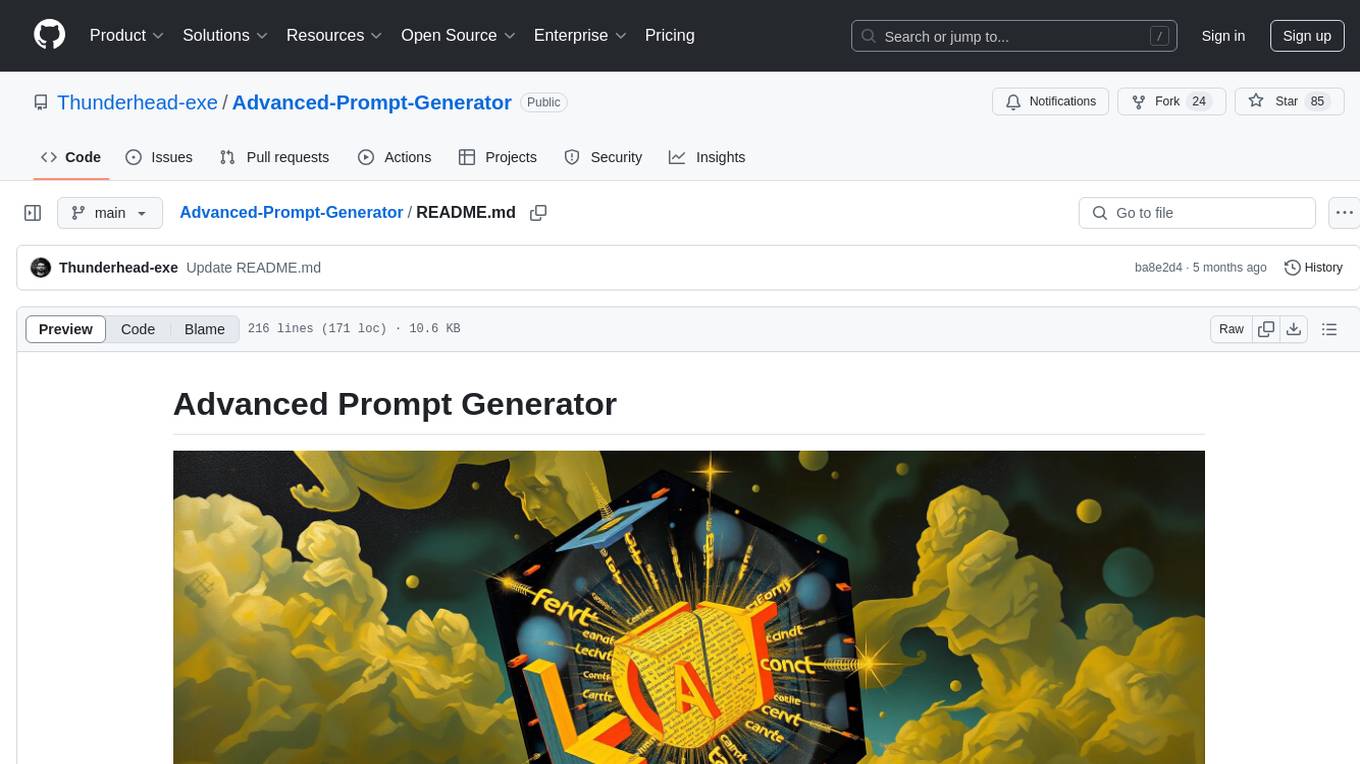
This project is an LLM-based Advanced Prompt Generator designed to automate the process of prompt engineering by enhancing given input prompts using large language models (LLMs). The tool can generate advanced prompts with minimal user input, leveraging LLM agents for optimized prompt generation. It supports gpt-4o or gpt-4o-mini, offers FastAPI & Docker deployment for efficiency, provides a Gradio interface for easy testing, and is hosted on Hugging Face Spaces for quick demos. Users can expand model support to offer more variety and flexibility.
README:
This project is an LLM-based Advanced Prompt Generator designed to automate the process of prompt engineering by enhancing given input prompts using large language models (LLMs). Following established prompt engineering principles, the tool can generate advanced prompts with a simple click, leveraging LLM agents for optimized prompt generation.
You can demo this solution on Hugging Face Spaces.
Also you can check this Medium article about this solution for more details!
- Automated Prompt Engineering: AI Agent based prompt engineering processes, requiring minimal user input.
- Uses OpenAI APIs: Support for gpt-4o or gpt-4o-mini (we recommend gpt-4o-mini).
- FastAPI & Docker Deployment: Ensures efficient and scalable backend deployment.
- Gradio Interface: Provides an easy-to-use interface for testing the prompt generation.
- Hugging Face Integration: Hosted on Hugging Face Spaces for quck demo.
- Expand Model Support: Integrate additional models to offer more variety and flexibility.
├── .gitignore # Files and directories to be ignored by Git
├── LICENSE # License information for the project
├── README.md # Project documentation (this file)
├── Advancd_Prompt_Generator.py # Script to test the tool locally
├── pipeline.py # Core logic for prompt enhancement
├── requirements.txt # Python dependencies for the project
├── Docker-FastAPI-app # Version deployed with FastAPI & Docker
│ ├── app
│ │ ├── main.py
│ │ ├── pipeline.py
│ ├── Dockerfile
│ ├── requirements.txt
├── Gradio-app # Version deployed with Gradio
│ ├── app.py
│ ├── pipeline.py
│ ├── requirements.txt
>>> Input Prompt:
how to write a book?
>>> Enhanced Prompt:
As a knowledgeable writing coach, please provide a comprehensive guide on how to write a book.
Requirements:
1. Outline the key steps involved in the book writing process, including brainstorming, outlining, drafting, and revising.
2. Offer tips for maintaining motivation and overcoming writer's block.
3. Include advice on setting a writing schedule and establishing a writing environment.
4. Suggest resources for further learning about writing techniques and publishing options.
Structure your response as follows:
- Introduction to the book writing journey
- Step-by-step guide with actionable tips
- Strategies for motivation and productivity
- Recommended resources for aspiring authors
Keep the response medium in length (approximately 200-300 words) to ensure thorough coverage of the topic.
##REFERENCE SUGGESTIONS##
- "On Writing: A Memoir of the Craft" by Stephen King
Purpose: Offers insights into the writing process and practical advice for aspiring authors
Integration: Use as a guide for understanding the nuances of writing a book
- "The Elements of Style" by William Strunk Jr. and E.B. White
Purpose: Provides essential rules of English style and composition
Integration: Reference for improving writing clarity and effectiveness
- "Bird by Bird: Some Instructions on Writing and Life" by Anne Lamott
Purpose: Shares personal anecdotes and practical tips for overcoming writing challenges
Integration: Use for motivation and strategies to tackle the writing process
##THOUGHT PROCESS##
*Subtask 1*:
- **Description**: Introduce the book writing journey and its significance.
- **Reasoning**: Providing an introduction sets the context for aspiring authors, helping them understand the importance and challenges of writing a book.
- **Success criteria**: The introduction should clearly articulate the purpose of writing a book and inspire readers about the journey ahead.
*Subtask 2*:
- **Description**: Outline the key steps involved in the book writing process: brainstorming, outlining, drafting, and revising.
- **Reasoning**: Breaking down the writing process into clear steps helps authors navigate their journey systematically and reduces overwhelm.
- **Success criteria**: Each step should be defined with actionable tips, such as techniques for brainstorming ideas, structuring an outline, and strategies for effective drafting and revising.
*Subtask 3*:
- **Description**: Provide tips for maintaining motivation and overcoming writer's block.
- **Reasoning**: Addressing common challenges like writer's block is crucial for sustaining progress and ensuring authors remain engaged with their writing.
- **Success criteria**: Include practical strategies, such as setting small goals, taking breaks, and using prompts to reignite creativity.
*Subtask 4*:
- **Description**: Advise on setting a writing schedule and establishing a conducive writing environment.
- **Reasoning**: A structured writing schedule and a supportive environment are essential for productivity and focus during the writing process.
- **Success criteria**: Offer specific recommendations for daily writing routines and tips for creating a distraction-free workspace.
*Subtask 5*:
- **Description**: Suggest resources for further learning about writing techniques and publishing options.
- **Reasoning**: Providing additional resources empowers authors to deepen their knowledge and explore various publishing avenues.
- **Success criteria**: List reputable books, websites, and courses that cover writing skills and the publishing process, ensuring they are accessible and relevant to aspiring authors.
>>> Input Prompt:
write a python script to compute and plot the fibonacci spiral
>>> Enhanced Prompt:
As a programming expert, please create a Python script that computes and plots the Fibonacci spiral.
Requirements:
- Use the Fibonacci sequence to generate the necessary points for the spiral.
- Utilize libraries such as Matplotlib for plotting and NumPy for numerical calculations.
- Include comments explaining each step of the code.
- Ensure the script is modular, allowing for easy adjustments to the number of Fibonacci terms used in the spiral.
Provide the implementation with:
- Function to compute Fibonacci numbers up to a specified term.
- Function to plot the Fibonacci spiral using the computed points.
- Example usage demonstrating the script in action, including a plot display.
The Fibonacci spiral should start with the first few Fibonacci numbers and visually represent the growth of the spiral based on these values.
##REFERENCE SUGGESTIONS##
- Matplotlib Documentation
Purpose: Provides details on plotting functions and customization options
Integration: Reference for creating and customizing plots in the script
- Fibonacci Sequence Article
Purpose: Offers insights into the mathematical properties and applications of the Fibonacci sequence
Integration: Use as a reference for understanding the sequence's generation and its relation to the spiral
- Python Programming Guide
Purpose: Serves as a comprehensive resource for Python syntax and libraries
Integration: Reference for general Python programming practices and functions used in the script
##THOUGHT PROCESS##
*Subtask 1*:
- **Description**: Create a function to compute Fibonacci numbers up to a specified term.
- **Reasoning**: This function is essential for generating the sequence of Fibonacci numbers, which will be used to determine the points for the spiral.
- **Success criteria**: The function should return a list of Fibonacci numbers up to the specified term, with correct values (e.g., for n=5, it should return [0, 1, 1, 2, 3]).
*Subtask 2*:
- **Description**: Implement a function to plot the Fibonacci spiral using the computed points.
- **Reasoning**: Plotting the spiral visually represents the growth of the Fibonacci sequence, making it easier to understand the relationship between the numbers and the spiral shape.
- **Success criteria**: The function should create a plot that accurately represents the Fibonacci spiral, with appropriate axes and labels, and should display the plot correctly.
*Subtask 3*:
- **Description**: Include comments explaining each step of the code.
- **Reasoning**: Comments enhance code readability and maintainability, allowing others (or the future self) to understand the logic and flow of the script.
- **Success criteria**: The code should have clear, concise comments that explain the purpose of each function and key steps within the functions.
*Subtask 4*:
- **Description**: Ensure the script is modular, allowing for easy adjustments to the number of Fibonacci terms used in the spiral.
- **Reasoning**: Modularity allows users to easily modify the number of terms without altering the core logic of the script, enhancing usability and flexibility.
- **Success criteria**: The script should allow the user to specify the number of Fibonacci terms as an input parameter, and the plot should update accordingly.
*Subtask 5*:
- **Description**: Provide example usage demonstrating the script in action, including a plot display.
- **Reasoning**: Example usage helps users understand how to implement and run the script, showcasing its functionality and output.
- **Success criteria**: The example should include a clear demonstration of how to call the functions, specify the number of terms, and display the resulting plot, with expected output shown.
- Clone the repository:
git clone https://github.com/Thunderhead-exe/Advanced-Prompt-Generator.git
- Install the dependencies:
pip install -r requirements.txt
- Run the app:
python3 Advancd_Prompt_Generator.py
This project is licensed under the terms of the apache-2.0 License.
Contributions are welcome! Please feel free to submit a Pull Request or open an Issue for any bug reports, feature requests, or general feedback.
For Tasks:
Click tags to check more tools for each tasksFor Jobs:
Alternative AI tools for Advanced-Prompt-Generator
Similar Open Source Tools

Advanced-Prompt-Generator
This project is an LLM-based Advanced Prompt Generator designed to automate the process of prompt engineering by enhancing given input prompts using large language models (LLMs). The tool can generate advanced prompts with minimal user input, leveraging LLM agents for optimized prompt generation. It supports gpt-4o or gpt-4o-mini, offers FastAPI & Docker deployment for efficiency, provides a Gradio interface for easy testing, and is hosted on Hugging Face Spaces for quick demos. Users can expand model support to offer more variety and flexibility.
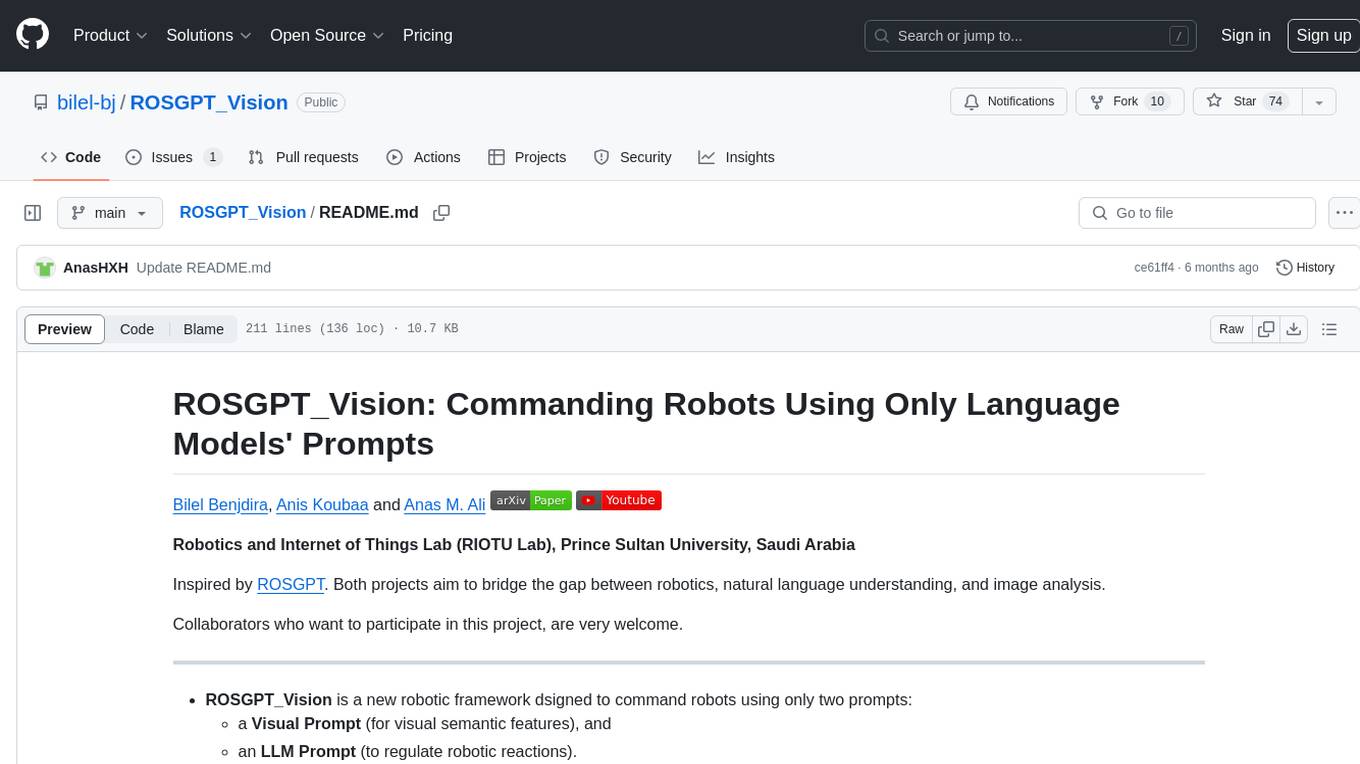
ROSGPT_Vision
ROSGPT_Vision is a new robotic framework designed to command robots using only two prompts: a Visual Prompt for visual semantic features and an LLM Prompt to regulate robotic reactions. It is based on the Prompting Robotic Modalities (PRM) design pattern and is used to develop CarMate, a robotic application for monitoring driver distractions and providing real-time vocal notifications. The framework leverages state-of-the-art language models to facilitate advanced reasoning about image data and offers a unified platform for robots to perceive, interpret, and interact with visual data through natural language. LangChain is used for easy customization of prompts, and the implementation includes the CarMate application for driver monitoring and assistance.
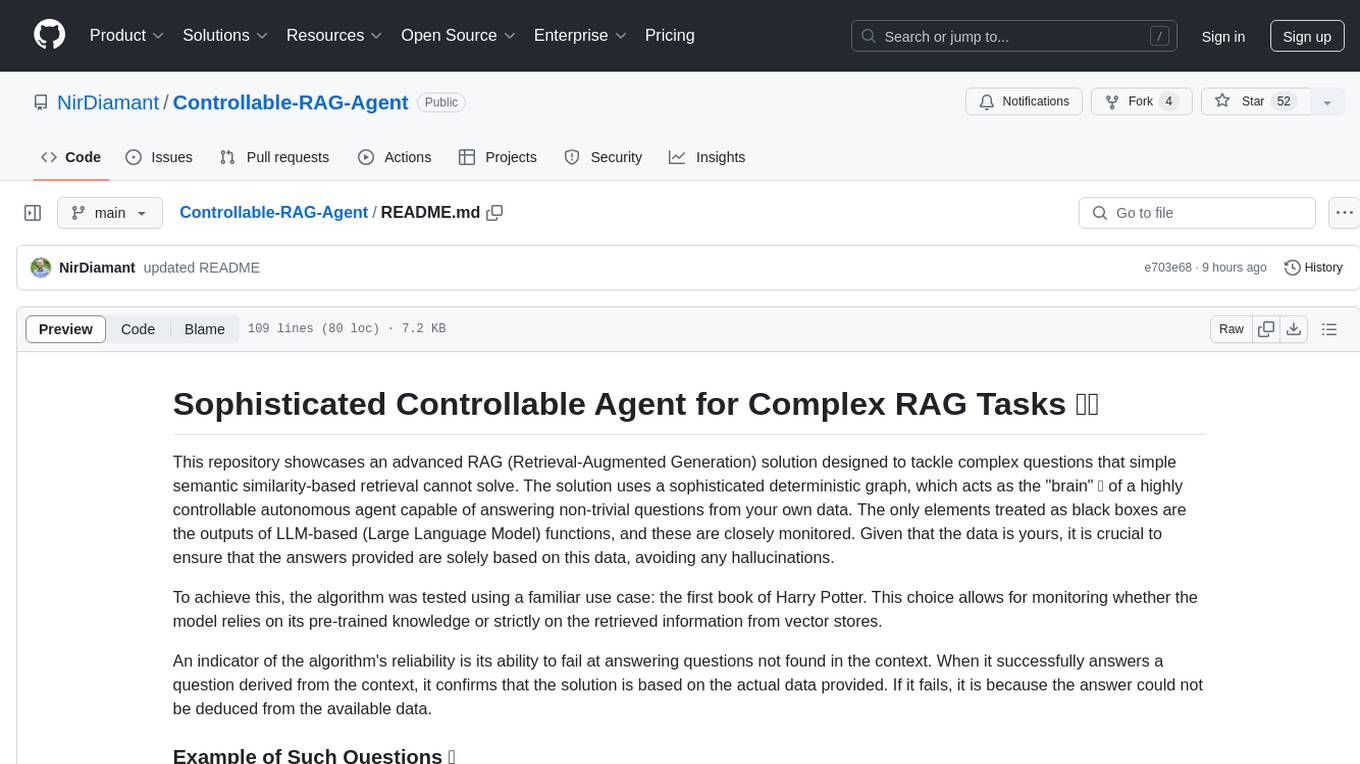
Controllable-RAG-Agent
This repository contains a sophisticated deterministic graph-based solution for answering complex questions using a controllable autonomous agent. The solution is designed to ensure that answers are solely based on the provided data, avoiding hallucinations. It involves various steps such as PDF loading, text preprocessing, summarization, database creation, encoding, and utilizing large language models. The algorithm follows a detailed workflow involving planning, retrieval, answering, replanning, content distillation, and performance evaluation. Heuristics and techniques implemented focus on content encoding, anonymizing questions, task breakdown, content distillation, chain of thought answering, verification, and model performance evaluation.
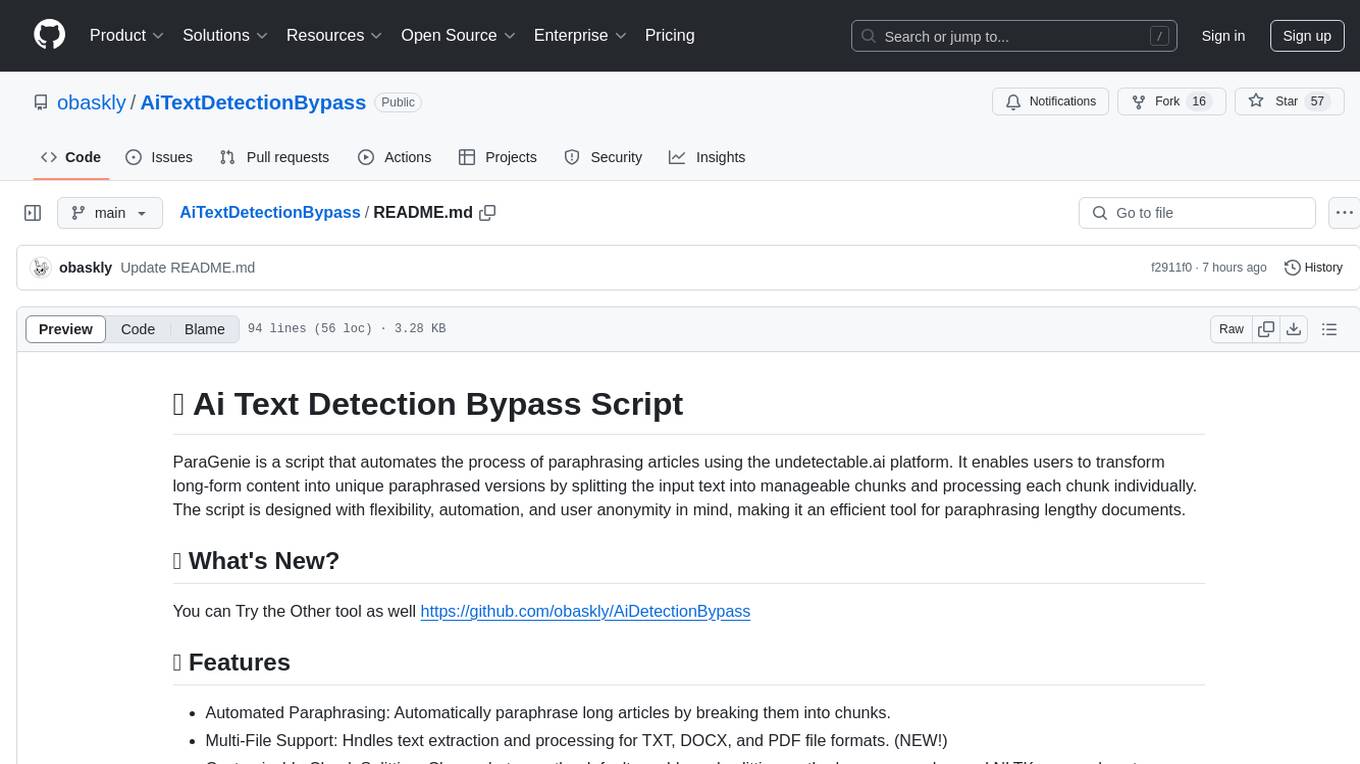
AiTextDetectionBypass
ParaGenie is a script designed to automate the process of paraphrasing articles using the undetectable.ai platform. It allows users to convert lengthy content into unique paraphrased versions by splitting the input text into manageable chunks and processing each chunk individually. The script offers features such as automated paraphrasing, multi-file support for TXT, DOCX, and PDF formats, customizable chunk splitting methods, Gmail-based registration for seamless paraphrasing, purpose-specific writing support, readability level customization, anonymity features for user privacy, error handling and recovery, and output management for easy access and organization of paraphrased content.
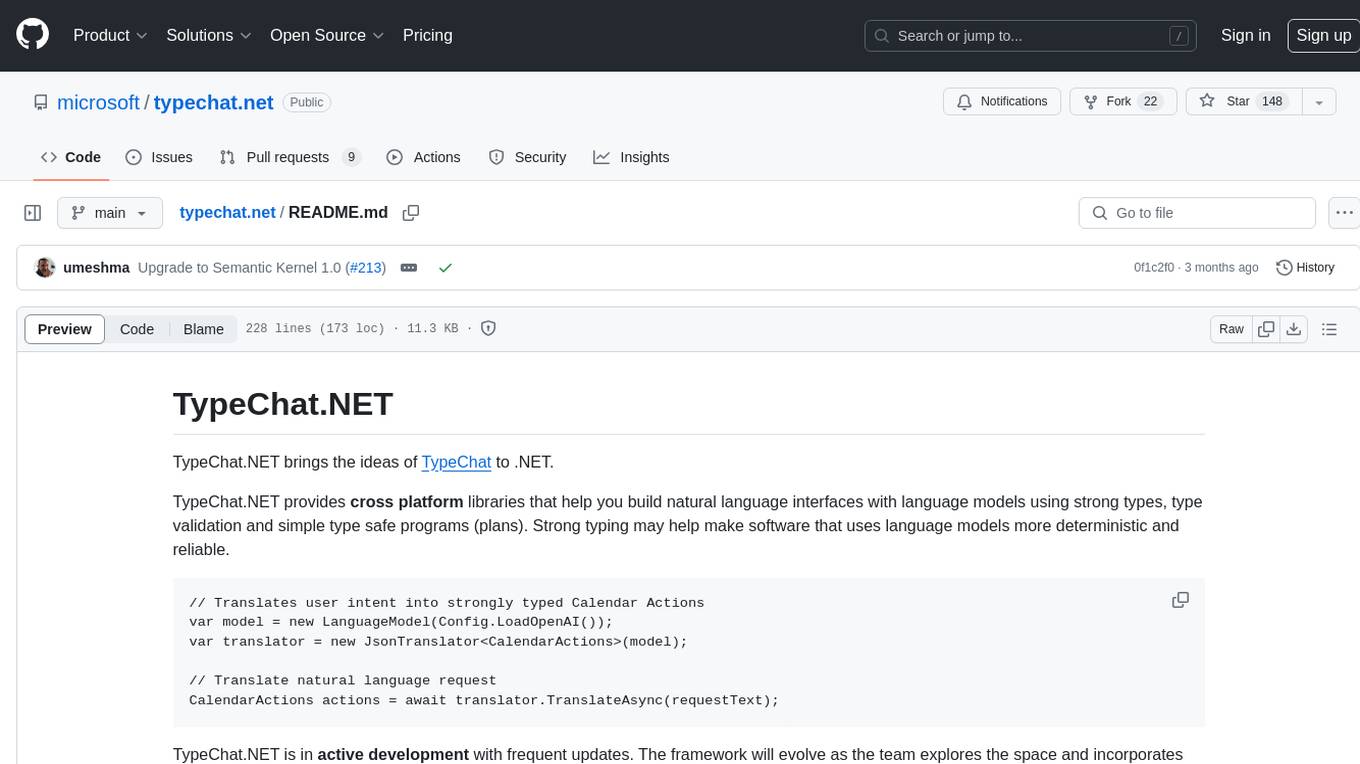
typechat.net
TypeChat.NET is a framework that provides cross-platform libraries for building natural language interfaces with language models using strong types, type validation, and simple type-safe programs. It translates user intent into strongly typed objects and JSON programs, with support for schema export, extensibility, and common scenarios. The framework is actively developed with frequent updates, evolving based on exploration and feedback. It consists of assemblies for translating user intent, synthesizing JSON programs, and integrating with Microsoft Semantic Kernel. TypeChat.NET requires familiarity with and access to OpenAI language models for its examples and scenarios.
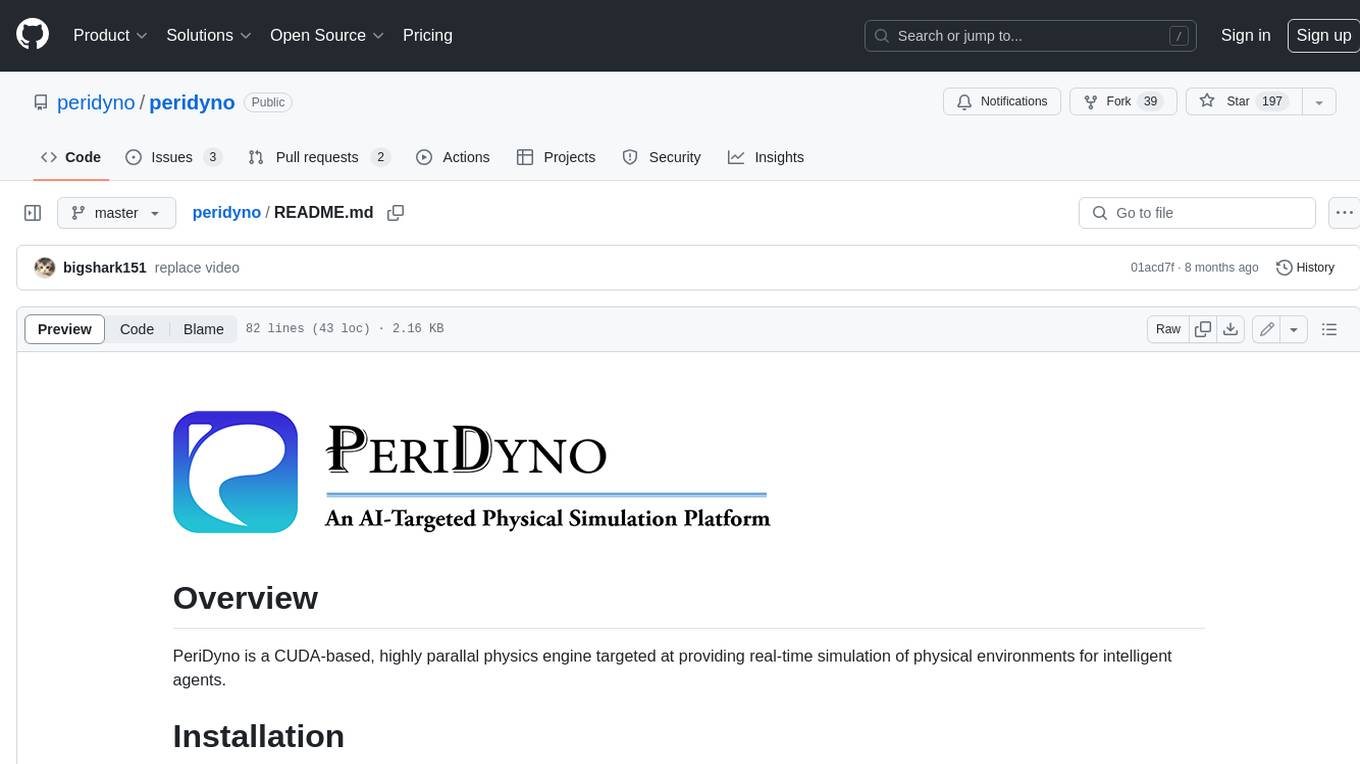
peridyno
PeriDyno is a CUDA-based, highly parallel physics engine targeted at providing real-time simulation of physical environments for intelligent agents. It is designed to be easy to use and integrate into existing projects, and it provides a wide range of features for simulating a variety of physical phenomena. PeriDyno is open source and available under the Apache 2.0 license.
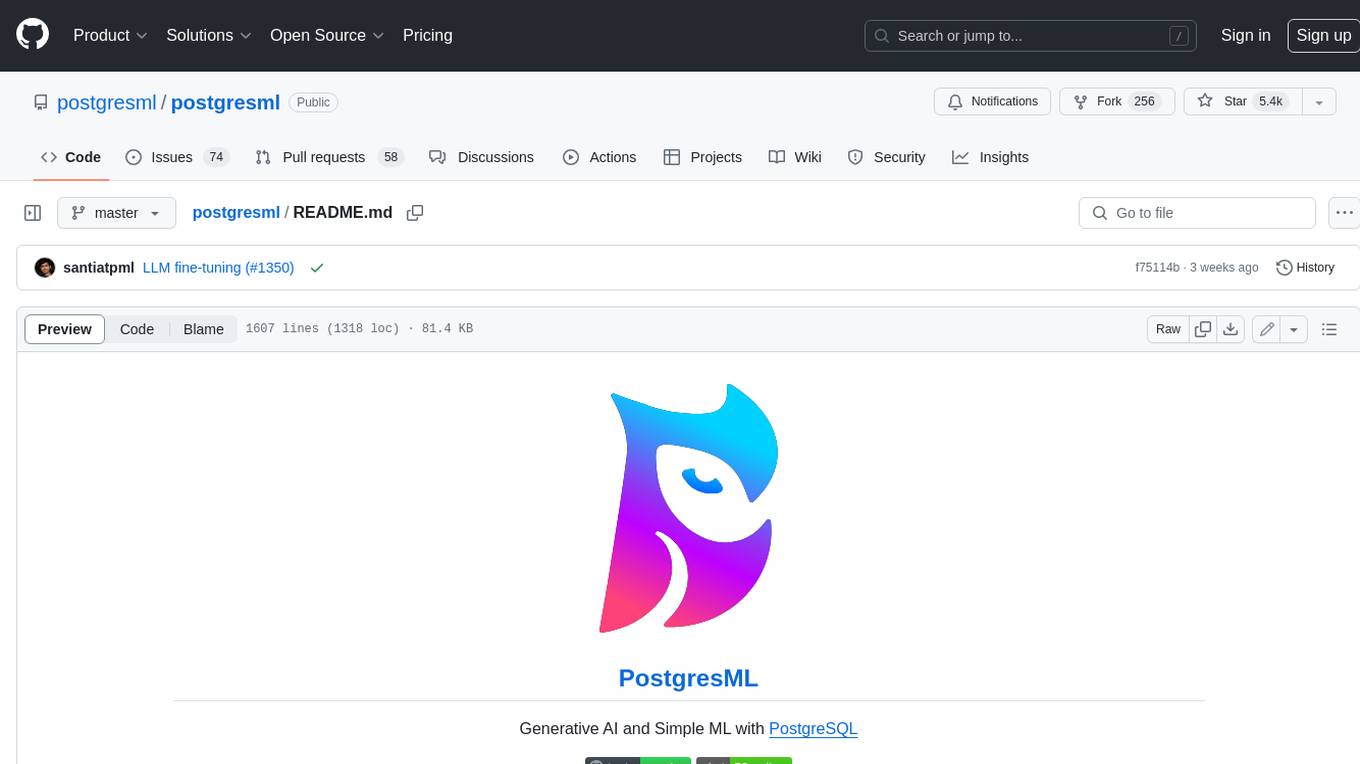
postgresml
PostgresML is a powerful Postgres extension that seamlessly combines data storage and machine learning inference within your database. It enables running machine learning and AI operations directly within PostgreSQL, leveraging GPU acceleration for faster computations, integrating state-of-the-art large language models, providing built-in functions for text processing, enabling efficient similarity search, offering diverse ML algorithms, ensuring high performance, scalability, and security, supporting a wide range of NLP tasks, and seamlessly integrating with existing PostgreSQL tools and client libraries.
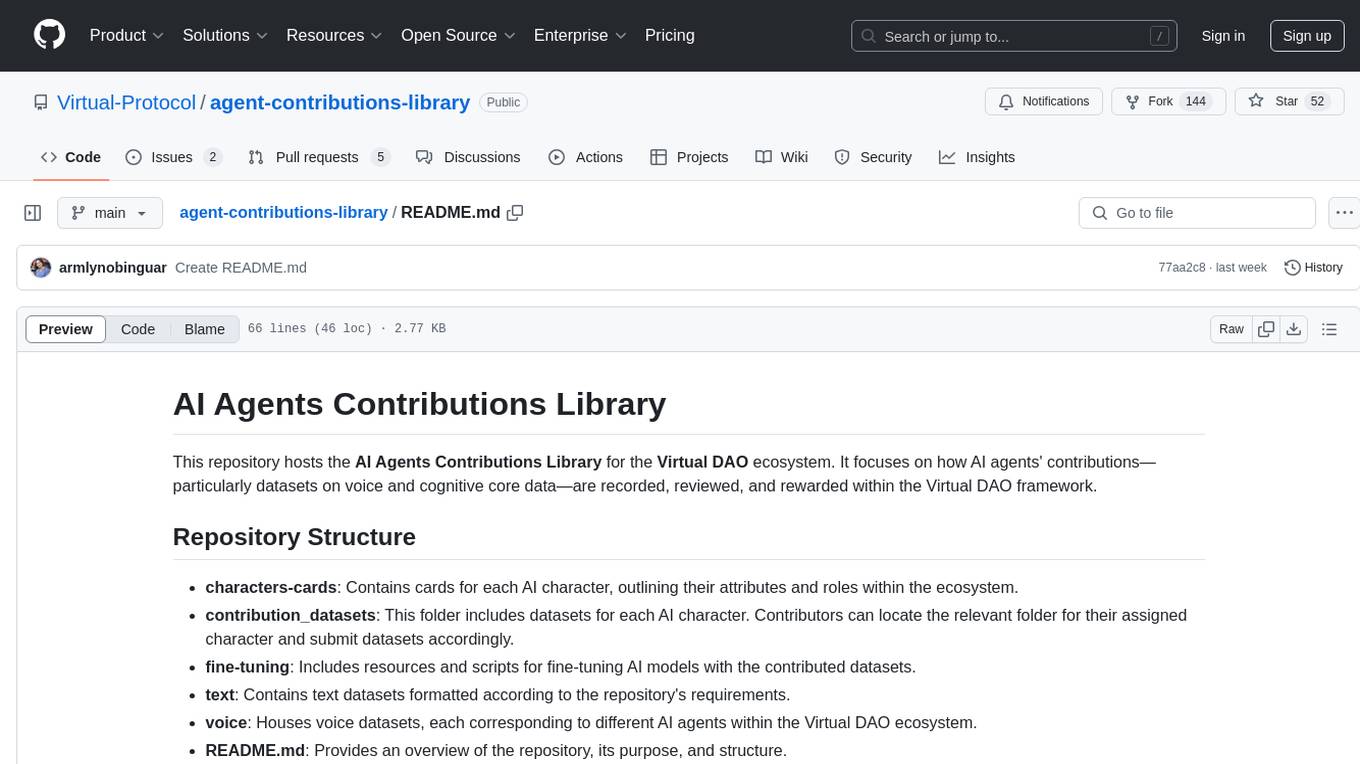
agent-contributions-library
The AI Agents Contributions Library is a repository dedicated to managing datasets on voice and cognitive core data for AI agents within the Virtual DAO ecosystem. It provides a structured framework for recording, reviewing, and rewarding contributions from contributors. The repository includes folders for character cards, contribution datasets, fine-tuning resources, text datasets, and voice datasets. Contributors can submit datasets following specific guidelines and formats, and the Virtual DAO team reviews and integrates approved datasets to enhance AI agents' capabilities.
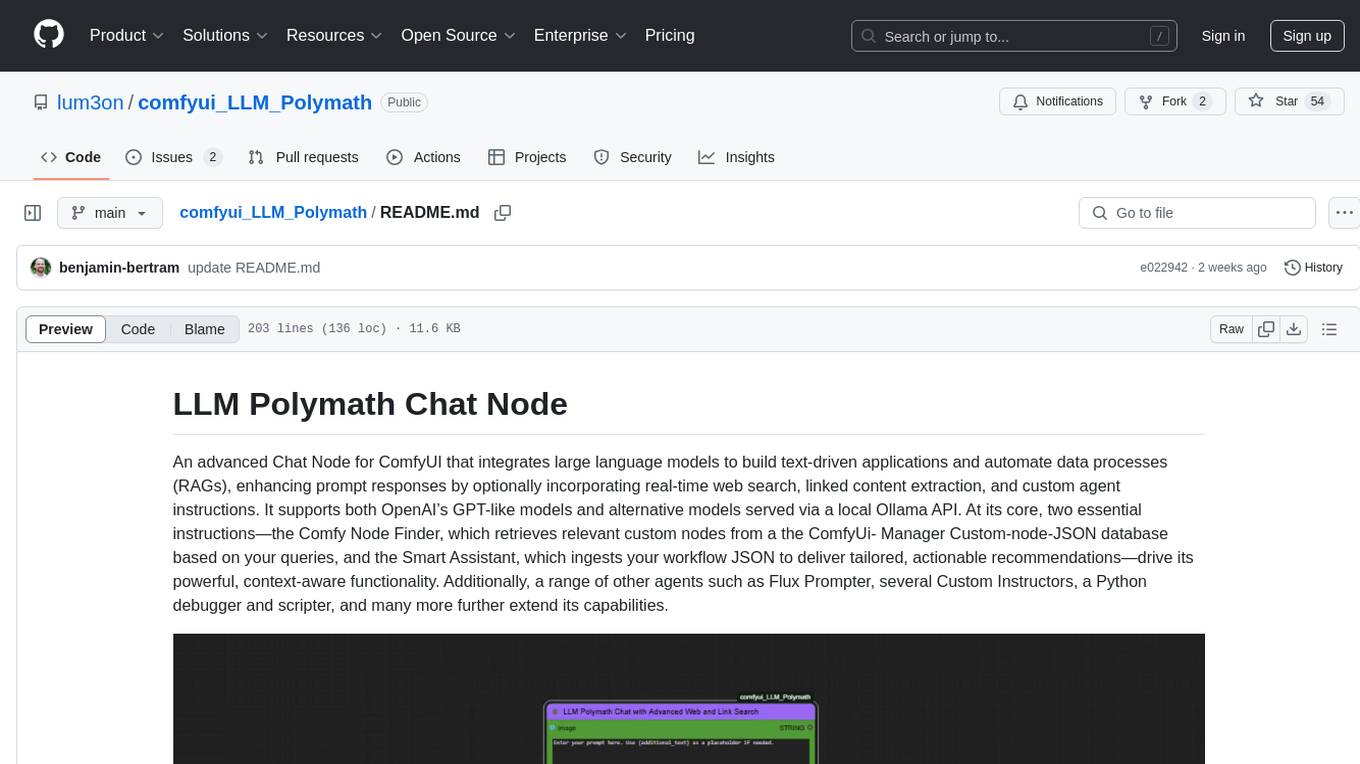
comfyui_LLM_Polymath
LLM Polymath Chat Node is an advanced Chat Node for ComfyUI that integrates large language models to build text-driven applications and automate data processes, enhancing prompt responses by incorporating real-time web search, linked content extraction, and custom agent instructions. It supports both OpenAI’s GPT-like models and alternative models served via a local Ollama API. The core functionalities include Comfy Node Finder and Smart Assistant, along with additional agents like Flux Prompter, Custom Instructors, Python debugger, and scripter. The tool offers features for prompt processing, web search integration, model & API integration, custom instructions, image handling, logging & debugging, output compression, and more.
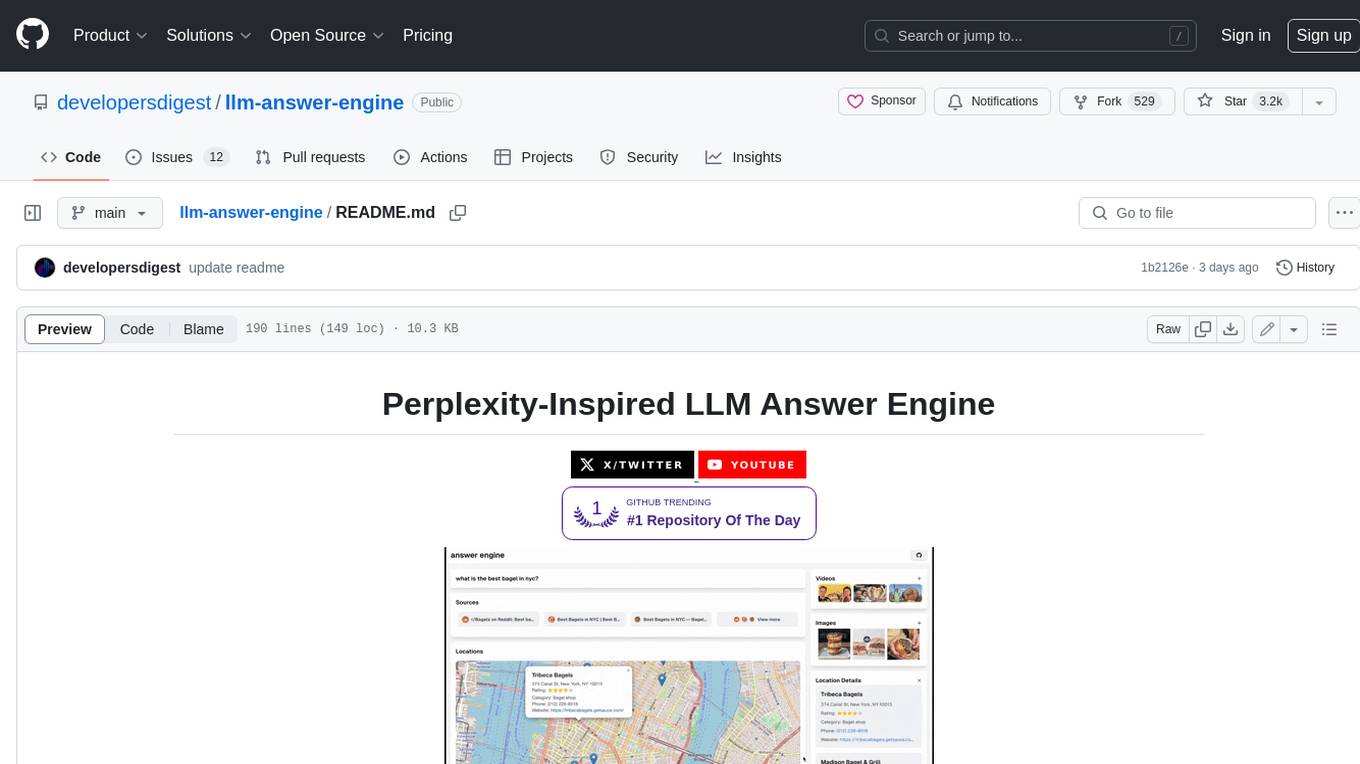
llm-answer-engine
This repository contains the code and instructions needed to build a sophisticated answer engine that leverages the capabilities of Groq, Mistral AI's Mixtral, Langchain.JS, Brave Search, Serper API, and OpenAI. Designed to efficiently return sources, answers, images, videos, and follow-up questions based on user queries, this project is an ideal starting point for developers interested in natural language processing and search technologies.
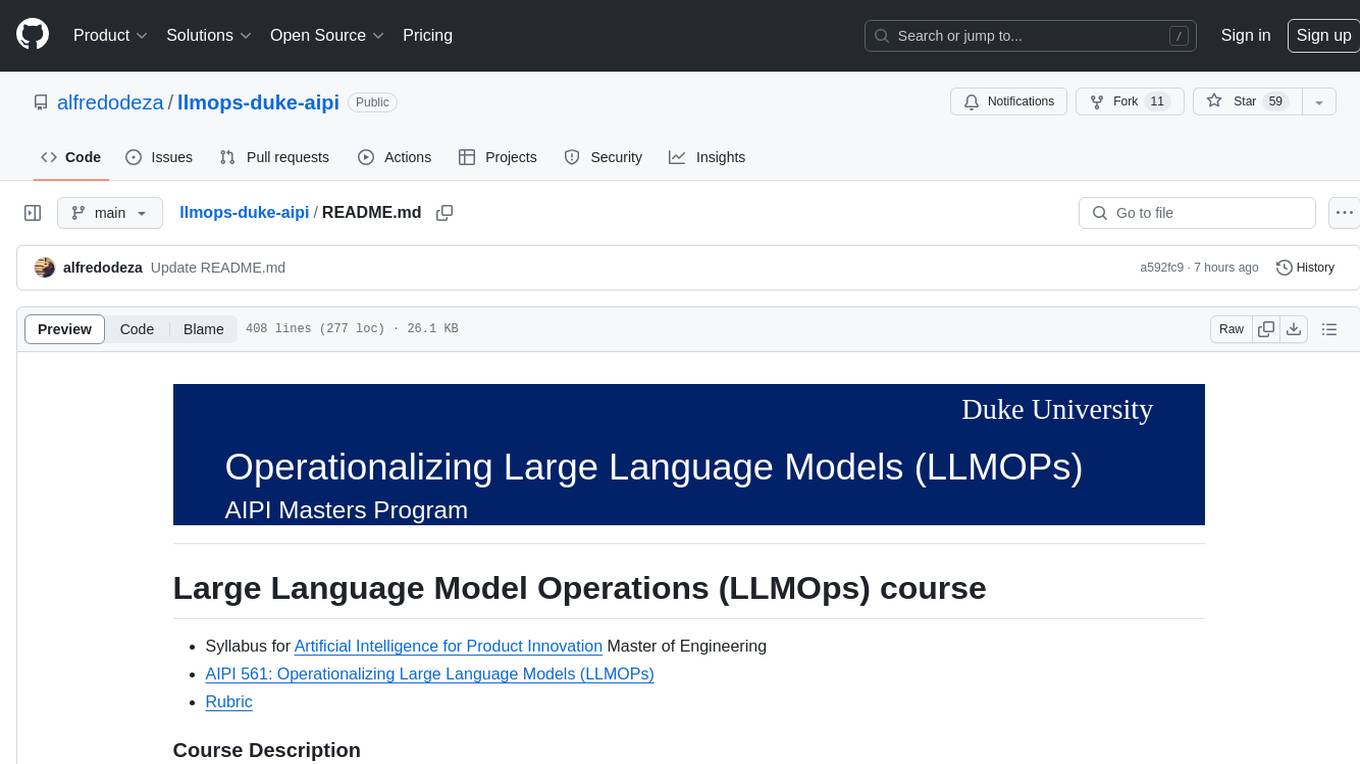
llmops-duke-aipi
LLMOps Duke AIPI is a course focused on operationalizing Large Language Models, teaching methodologies for developing applications using software development best practices with large language models. The course covers various topics such as generative AI concepts, setting up development environments, interacting with large language models, using local large language models, applied solutions with LLMs, extensibility using plugins and functions, retrieval augmented generation, introduction to Python web frameworks for APIs, DevOps principles, deploying machine learning APIs, LLM platforms, and final presentations. Students will learn to build, share, and present portfolios using Github, YouTube, and Linkedin, as well as develop non-linear life-long learning skills. Prerequisites include basic Linux and programming skills, with coursework available in Python or Rust. Additional resources and references are provided for further learning and exploration.
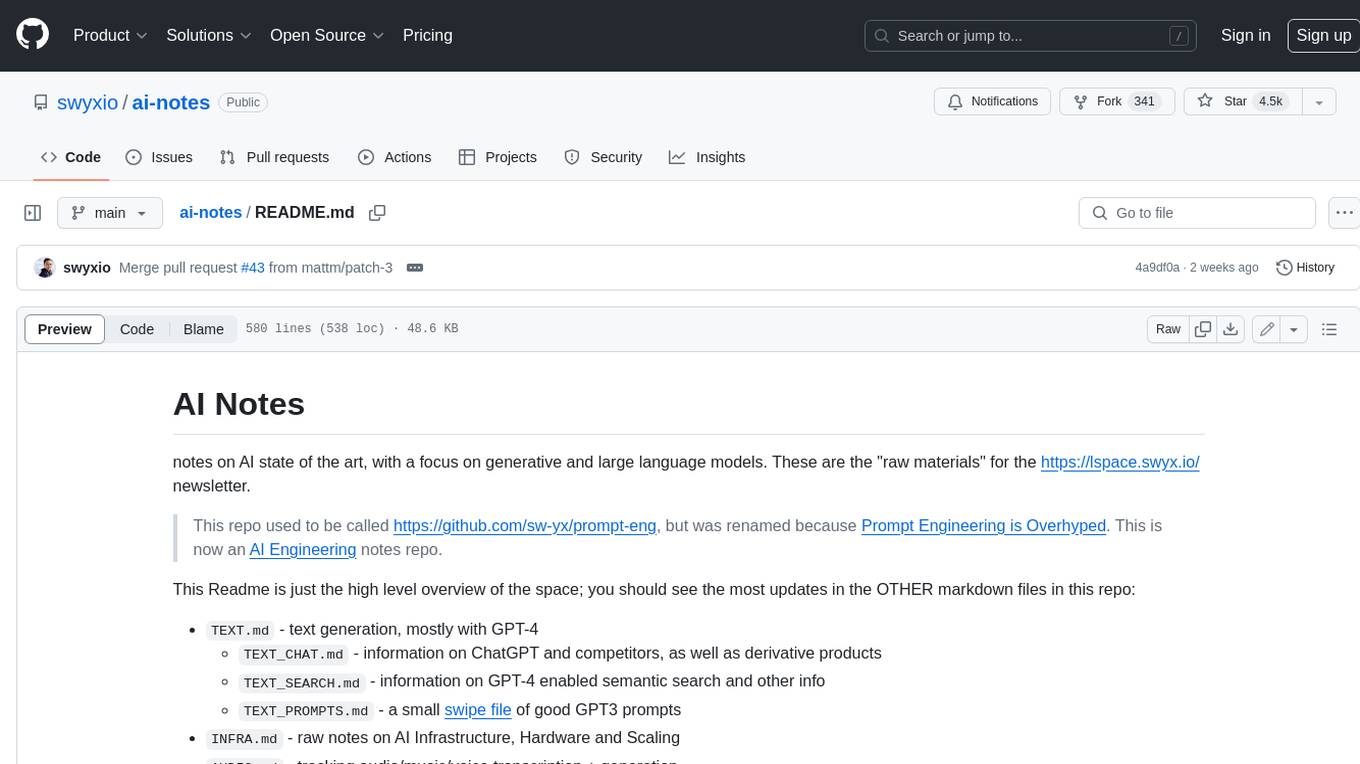
ai-notes
Notes on AI state of the art, with a focus on generative and large language models. These are the "raw materials" for the https://lspace.swyx.io/ newsletter. This repo used to be called https://github.com/sw-yx/prompt-eng, but was renamed because Prompt Engineering is Overhyped. This is now an AI Engineering notes repo.

crewAI
CrewAI is a cutting-edge framework designed to orchestrate role-playing autonomous AI agents. By fostering collaborative intelligence, CrewAI empowers agents to work together seamlessly, tackling complex tasks. It enables AI agents to assume roles, share goals, and operate in a cohesive unit, much like a well-oiled crew. Whether you're building a smart assistant platform, an automated customer service ensemble, or a multi-agent research team, CrewAI provides the backbone for sophisticated multi-agent interactions. With features like role-based agent design, autonomous inter-agent delegation, flexible task management, and support for various LLMs, CrewAI offers a dynamic and adaptable solution for both development and production workflows.
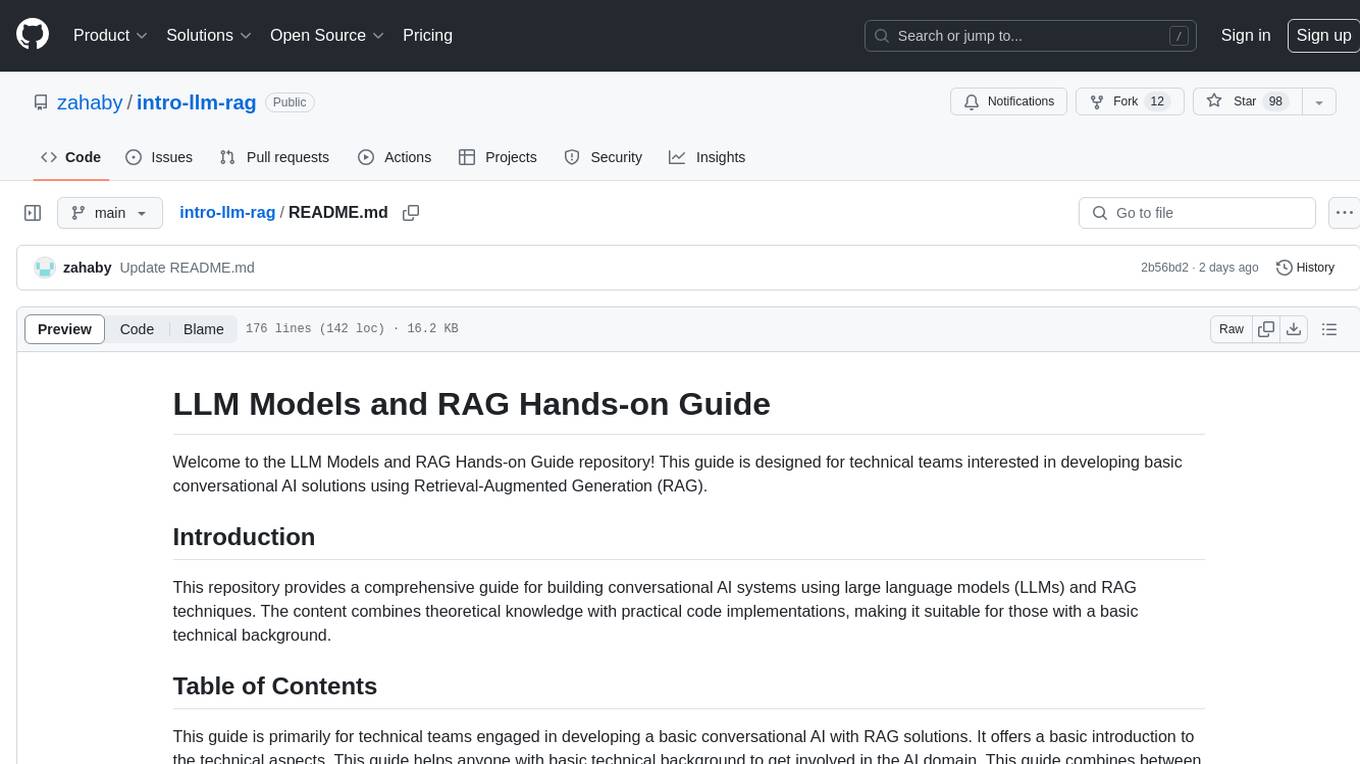
intro-llm-rag
This repository serves as a comprehensive guide for technical teams interested in developing conversational AI solutions using Retrieval-Augmented Generation (RAG) techniques. It covers theoretical knowledge and practical code implementations, making it suitable for individuals with a basic technical background. The content includes information on large language models (LLMs), transformers, prompt engineering, embeddings, vector stores, and various other key concepts related to conversational AI. The repository also provides hands-on examples for two different use cases, along with implementation details and performance analysis.
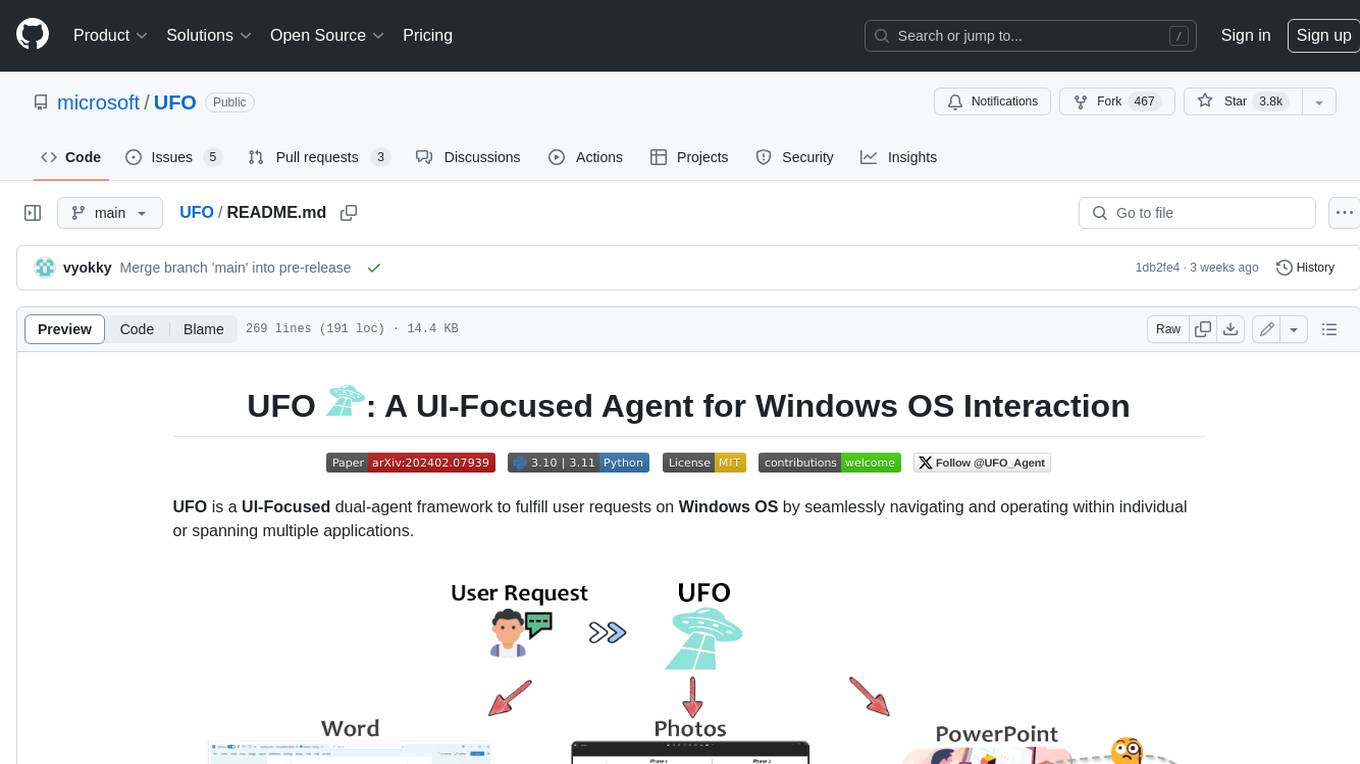
UFO
UFO is a UI-focused dual-agent framework to fulfill user requests on Windows OS by seamlessly navigating and operating within individual or spanning multiple applications.
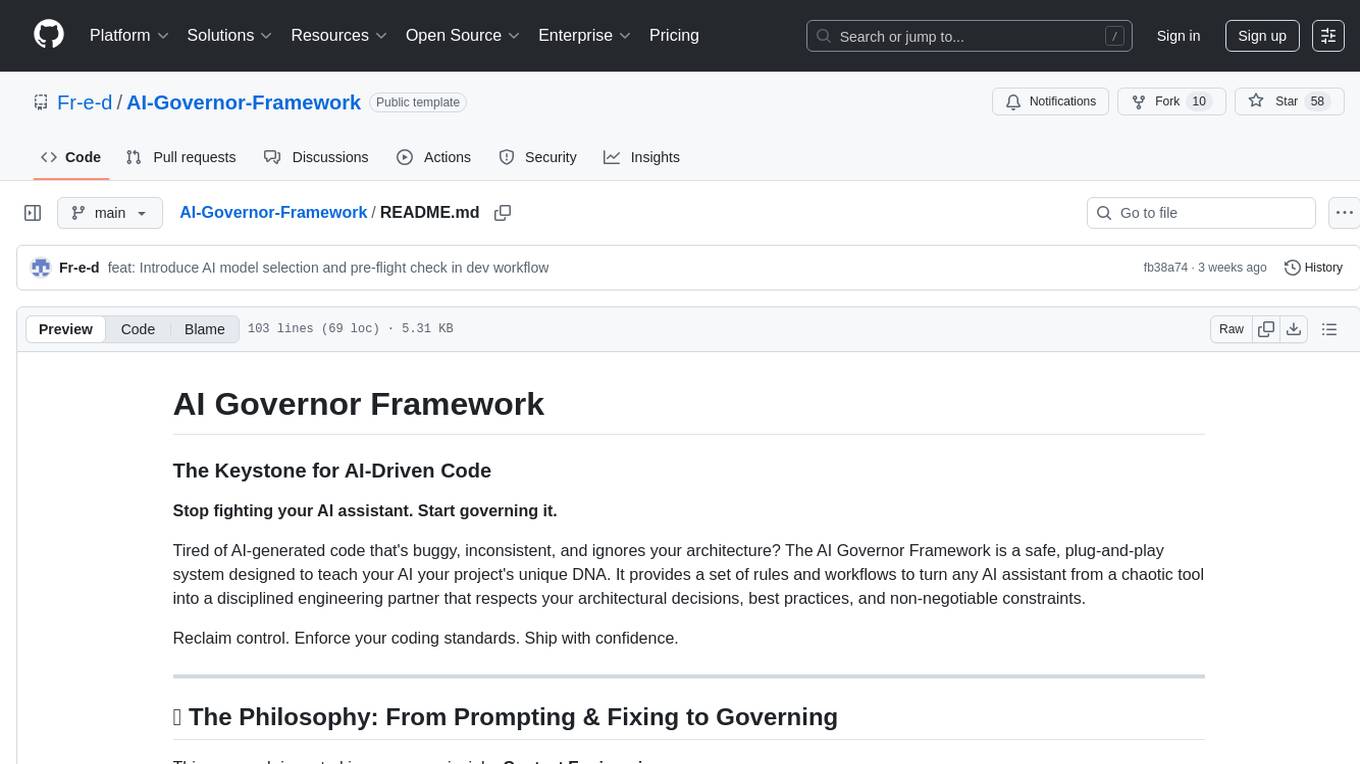
AI-Governor-Framework
The AI Governor Framework is a system designed to govern AI assistants in coding projects by providing rules and workflows to ensure consistency, respect architectural decisions, and enforce coding standards. It leverages Context Engineering to provide the AI with the right information at the right time, using an In-Repo approach to keep governance rules and architectural context directly inside the repository. The framework consists of two core components: The Governance Engine for passive rules and the Operator's Playbook for active protocols. It follows a 4-step Operator's Playbook to move features from idea to production with clarity and control.
For similar tasks
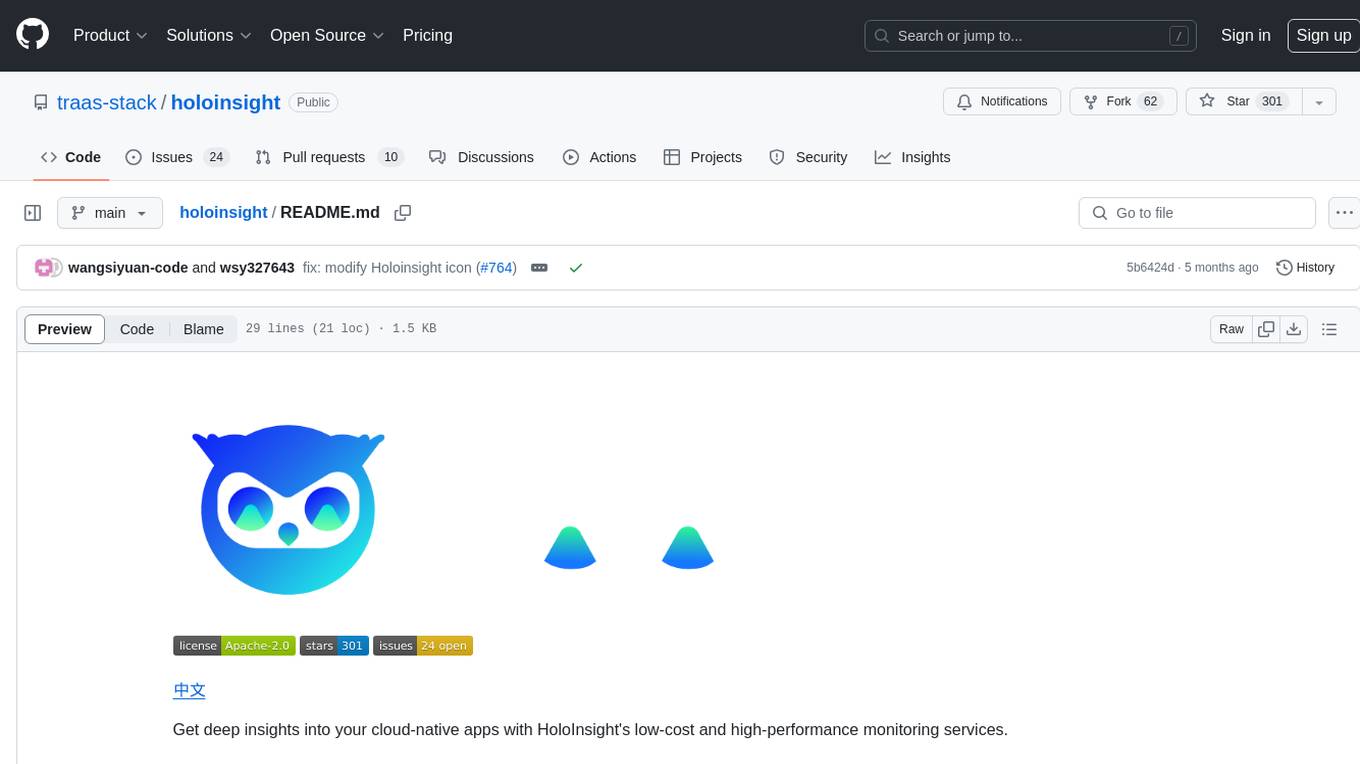
holoinsight
HoloInsight is a cloud-native observability platform that provides low-cost and high-performance monitoring services for cloud-native applications. It offers deep insights through real-time log analysis and AI integration. The platform is designed to help users gain a comprehensive understanding of their applications' performance and behavior in the cloud environment. HoloInsight is easy to deploy using Docker and Kubernetes, making it a versatile tool for monitoring and optimizing cloud-native applications. With a focus on scalability and efficiency, HoloInsight is suitable for organizations looking to enhance their observability and monitoring capabilities in the cloud.
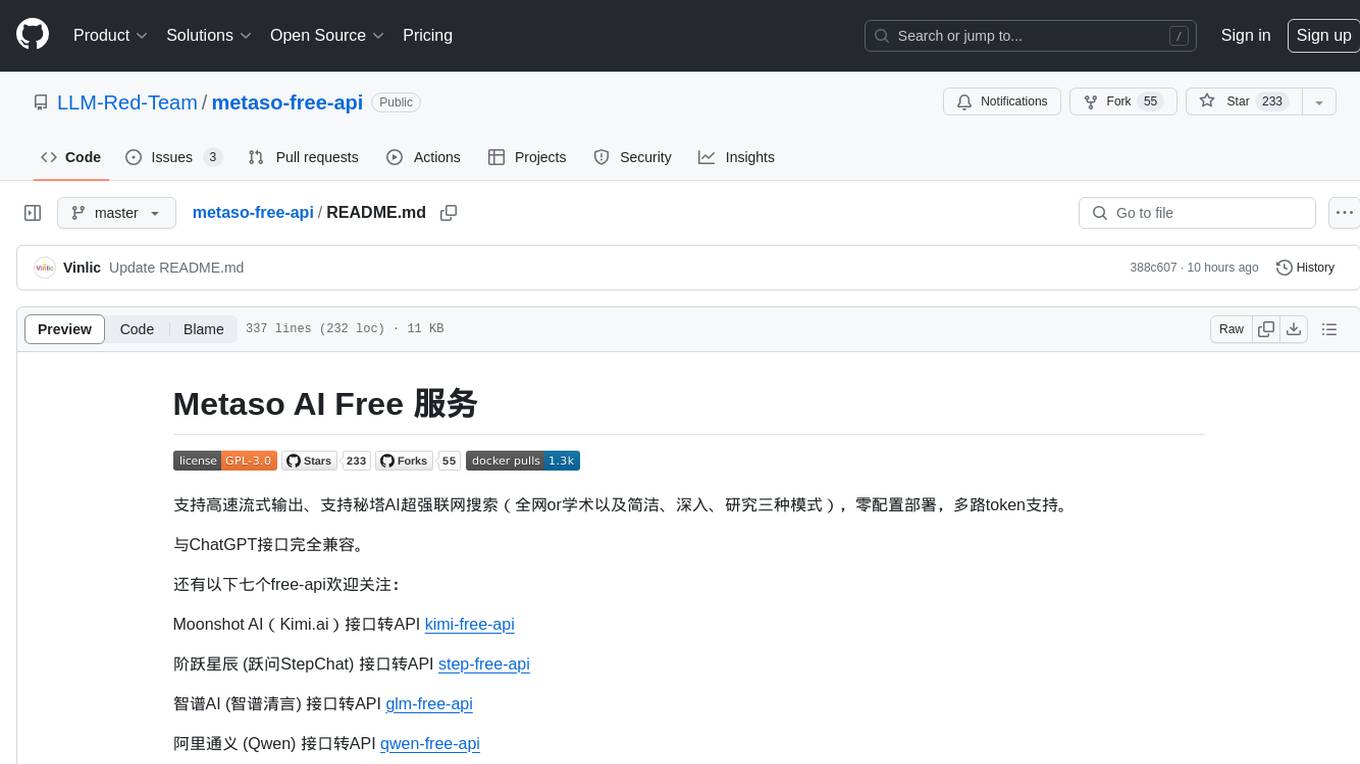
metaso-free-api
Metaso AI Free service supports high-speed streaming output, secret tower AI super network search (full network or academic as well as concise, in-depth, research three modes), zero-configuration deployment, multi-token support. Fully compatible with ChatGPT interface. It also has seven other free APIs available for use. The tool provides various deployment options such as Docker, Docker-compose, Render, Vercel, and native deployment. Users can access the tool for chat completions and token live checks. Note: Reverse API is unstable, it is recommended to use the official Metaso AI website to avoid the risk of banning. This project is for research and learning purposes only, not for commercial use.
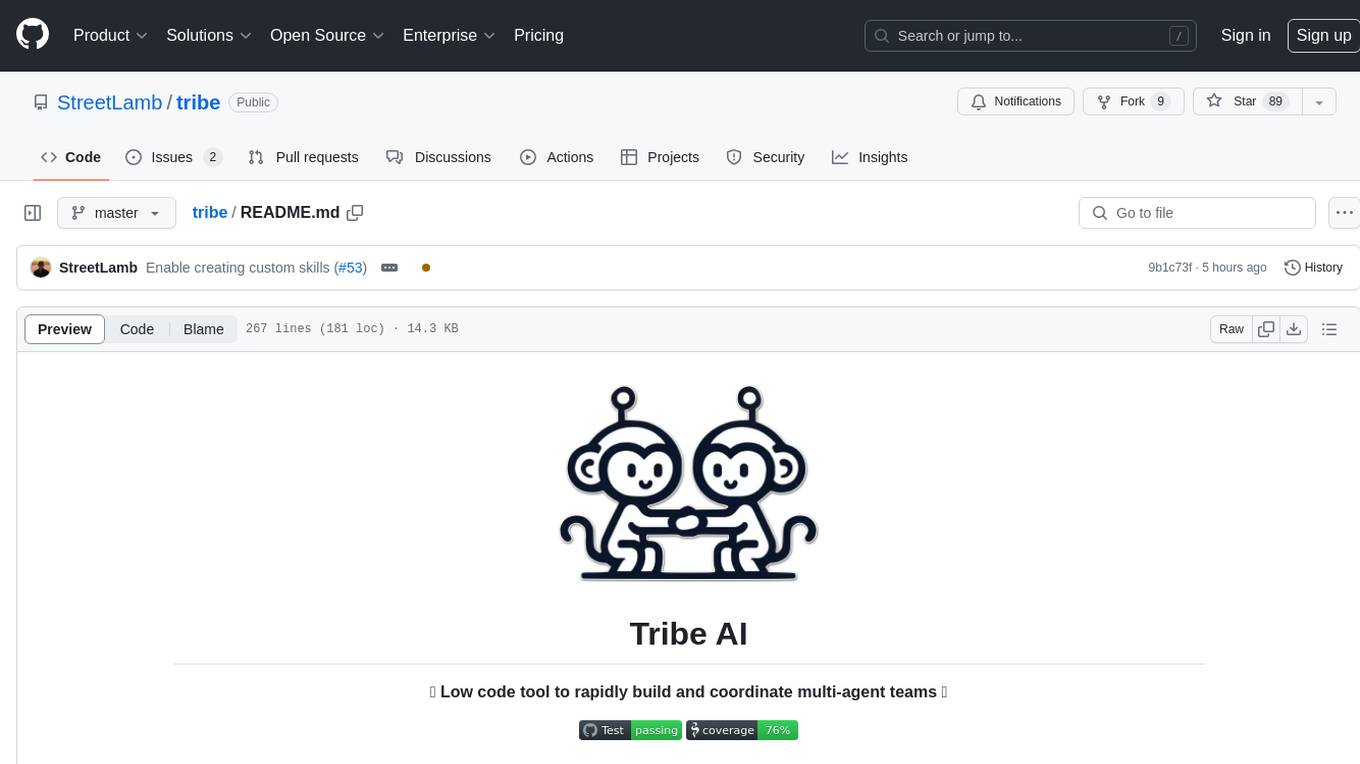
tribe
Tribe AI is a low code tool designed to rapidly build and coordinate multi-agent teams. It leverages the langgraph framework to customize and coordinate teams of agents, allowing tasks to be split among agents with different strengths for faster and better problem-solving. The tool supports persistent conversations, observability, tool calling, human-in-the-loop functionality, easy deployment with Docker, and multi-tenancy for managing multiple users and teams.
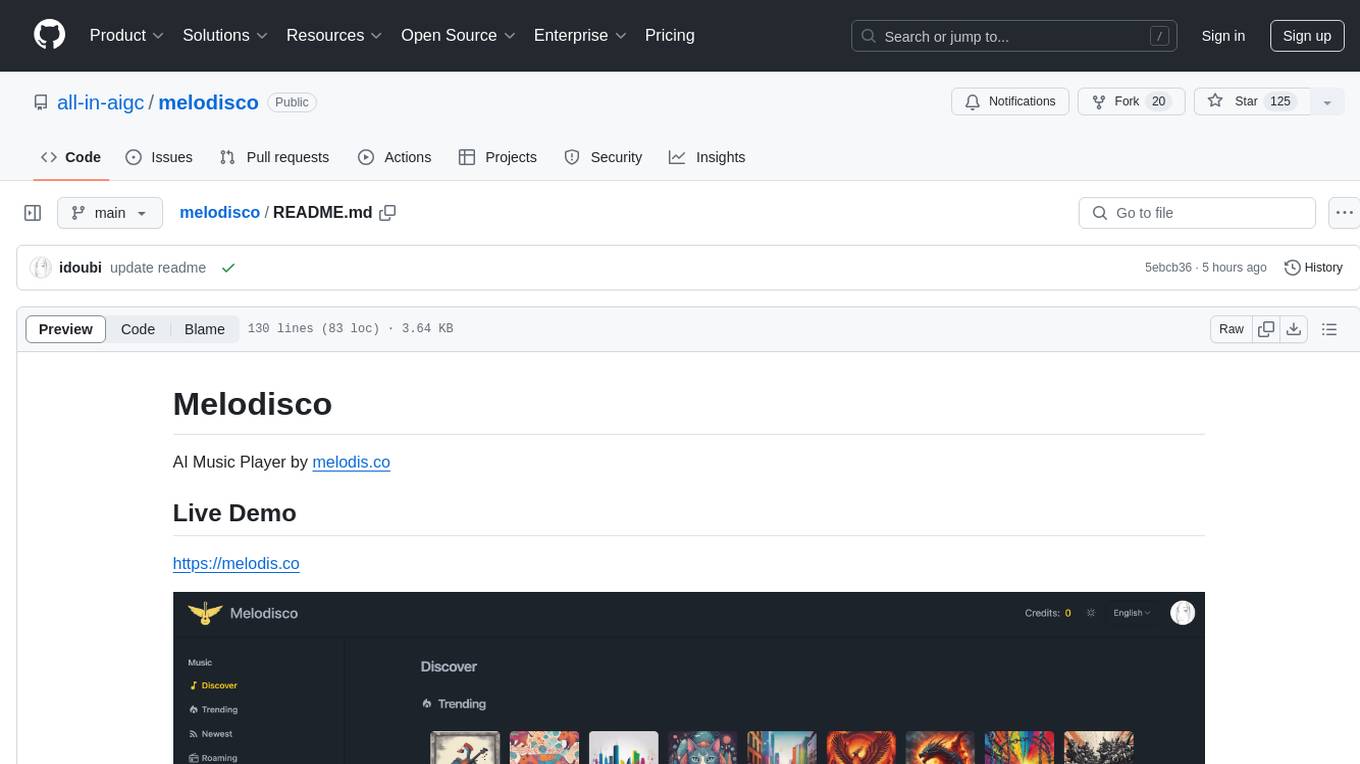
melodisco
Melodisco is an AI music player that allows users to listen to music and manage playlists. It provides a user-friendly interface for music playback and organization. Users can deploy Melodisco with Vercel or Docker for easy setup. Local development instructions are provided for setting up the project environment. The project credits various tools and libraries used in its development, such as Next.js, Tailwind CSS, and Stripe. Melodisco is a versatile tool for music enthusiasts looking for an AI-powered music player with features like authentication, payment integration, and multi-language support.
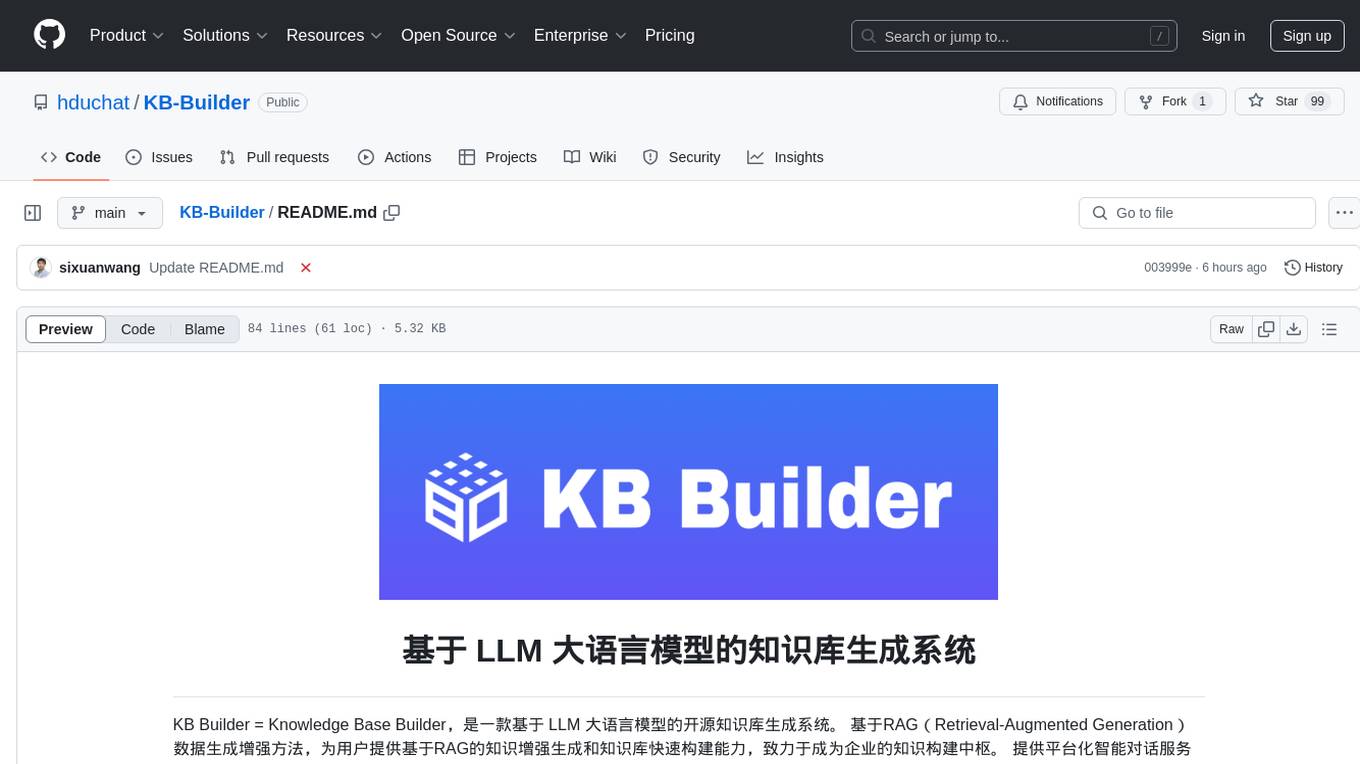
KB-Builder
KB Builder is an open-source knowledge base generation system based on the LLM large language model. It utilizes the RAG (Retrieval-Augmented Generation) data generation enhancement method to provide users with the ability to enhance knowledge generation and quickly build knowledge bases based on RAG. It aims to be the central hub for knowledge construction in enterprises, offering platform-based intelligent dialogue services and document knowledge base management functionality. Users can upload docx, pdf, txt, and md format documents and generate high-quality knowledge base question-answer pairs by invoking large models through the 'Parse Document' feature.
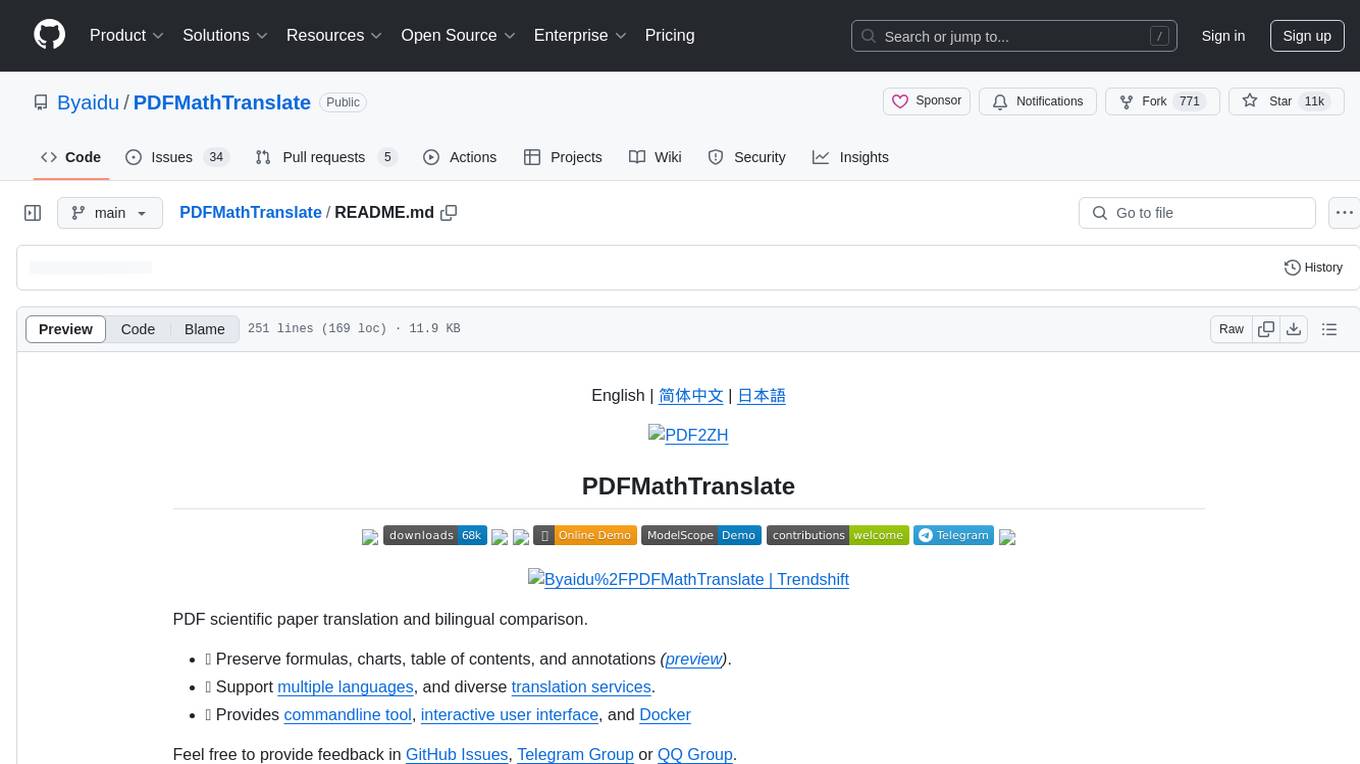
PDFMathTranslate
PDFMathTranslate is a tool designed for translating scientific papers and conducting bilingual comparisons. It preserves formulas, charts, table of contents, and annotations. The tool supports multiple languages and diverse translation services. It provides a command-line tool, interactive user interface, and Docker deployment. Users can try the application through online demos. The tool offers various installation methods including command-line, portable, graphic user interface, and Docker. Advanced options allow users to customize translation settings. Additionally, the tool supports secondary development through APIs for Python and HTTP. Future plans include parsing layout with DocLayNet based models, fixing page rotation and format issues, supporting non-PDF/A files, and integrating plugins for Zotero and Obsidian.

grps_trtllm
The grps-trtllm repository is a C++ implementation of a high-performance OpenAI LLM service, combining GRPS and TensorRT-LLM. It supports functionalities like Chat, Ai-agent, and Multi-modal. The repository offers advantages over triton-trtllm, including a complete LLM service implemented in pure C++, integrated tokenizer supporting huggingface and sentencepiece, custom HTTP functionality for OpenAI interface, support for different LLM prompt styles and result parsing styles, integration with tensorrt backend and opencv library for multi-modal LLM, and stable performance improvement compared to triton-trtllm.

discord-ai-bot
Discord AI Bot is a chatbot tool designed to interact with Ollama and AUTOMATIC1111 Stable Diffusion on Discord. The bot allows users to set up and configure a Discord bot to communicate with the mentioned AI models. Users can follow step-by-step instructions to install Node.js, Ollama, and the required dependencies, create a Discord bot, and interact with the bot by mentioning it in messages. Additionally, the tool provides set-up instructions for Docker users to easily deploy the bot using Docker containers. Overall, Discord AI Bot simplifies the process of integrating AI chatbots into Discord servers for interactive communication.
For similar jobs

sweep
Sweep is an AI junior developer that turns bugs and feature requests into code changes. It automatically handles developer experience improvements like adding type hints and improving test coverage.

teams-ai
The Teams AI Library is a software development kit (SDK) that helps developers create bots that can interact with Teams and Microsoft 365 applications. It is built on top of the Bot Framework SDK and simplifies the process of developing bots that interact with Teams' artificial intelligence capabilities. The SDK is available for JavaScript/TypeScript, .NET, and Python.

ai-guide
This guide is dedicated to Large Language Models (LLMs) that you can run on your home computer. It assumes your PC is a lower-end, non-gaming setup.

classifai
Supercharge WordPress Content Workflows and Engagement with Artificial Intelligence. Tap into leading cloud-based services like OpenAI, Microsoft Azure AI, Google Gemini and IBM Watson to augment your WordPress-powered websites. Publish content faster while improving SEO performance and increasing audience engagement. ClassifAI integrates Artificial Intelligence and Machine Learning technologies to lighten your workload and eliminate tedious tasks, giving you more time to create original content that matters.

chatbot-ui
Chatbot UI is an open-source AI chat app that allows users to create and deploy their own AI chatbots. It is easy to use and can be customized to fit any need. Chatbot UI is perfect for businesses, developers, and anyone who wants to create a chatbot.

BricksLLM
BricksLLM is a cloud native AI gateway written in Go. Currently, it provides native support for OpenAI, Anthropic, Azure OpenAI and vLLM. BricksLLM aims to provide enterprise level infrastructure that can power any LLM production use cases. Here are some use cases for BricksLLM: * Set LLM usage limits for users on different pricing tiers * Track LLM usage on a per user and per organization basis * Block or redact requests containing PIIs * Improve LLM reliability with failovers, retries and caching * Distribute API keys with rate limits and cost limits for internal development/production use cases * Distribute API keys with rate limits and cost limits for students

uAgents
uAgents is a Python library developed by Fetch.ai that allows for the creation of autonomous AI agents. These agents can perform various tasks on a schedule or take action on various events. uAgents are easy to create and manage, and they are connected to a fast-growing network of other uAgents. They are also secure, with cryptographically secured messages and wallets.

griptape
Griptape is a modular Python framework for building AI-powered applications that securely connect to your enterprise data and APIs. It offers developers the ability to maintain control and flexibility at every step. Griptape's core components include Structures (Agents, Pipelines, and Workflows), Tasks, Tools, Memory (Conversation Memory, Task Memory, and Meta Memory), Drivers (Prompt and Embedding Drivers, Vector Store Drivers, Image Generation Drivers, Image Query Drivers, SQL Drivers, Web Scraper Drivers, and Conversation Memory Drivers), Engines (Query Engines, Extraction Engines, Summary Engines, Image Generation Engines, and Image Query Engines), and additional components (Rulesets, Loaders, Artifacts, Chunkers, and Tokenizers). Griptape enables developers to create AI-powered applications with ease and efficiency.



